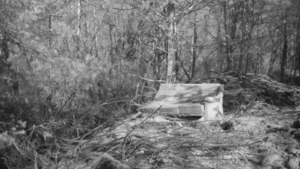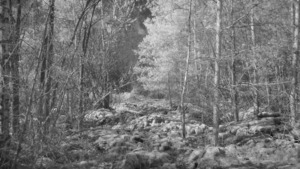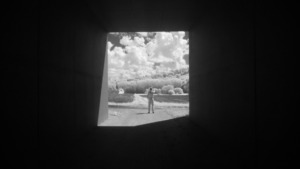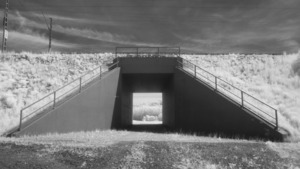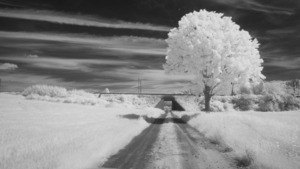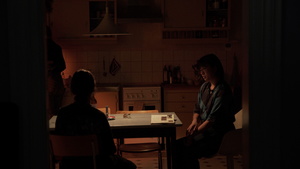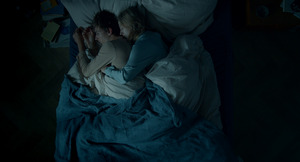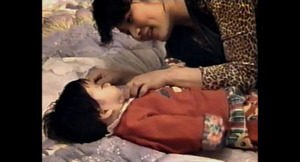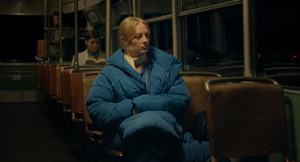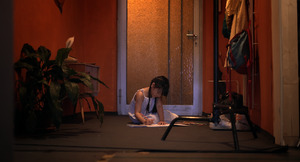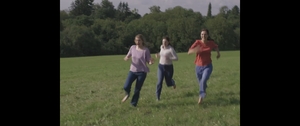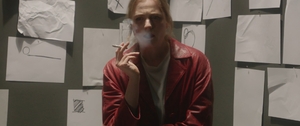"Filmstill"
| Begriff | Filmstill |
| Metakey | Beziehung/Funktion (media_object:relationship) |
| Typ | Keyword |
| Vokabular | Medienobjekt |
39 Inhalte
- Seite 1 von 4
HARNESSING THE CURRENT Filmstill
- Titel
- HARNESSING THE CURRENT Filmstill
- Titel (en)
- HARNESSING THE CURRENT – on Catching Liminality
- Untertitel
- on Catching Liminaity
- Autor/in
- Beschreibung (de)
- "HARNESSING THE CURRENT – on Catching Liminality" ist ein Kurzfilm über das absurde und antreibende Potential des Dazwischenseins (eng. liminality).
Vervollständigt wird die Installation durch ein Toninstrument: Im Film stellt es das (be-)Greifen einer neuen Lebensansicht dar. Das Design, welches nur einen musikalischen Ton zulässt, fungiert darüber hinaus als Werkzeug zur Meditation, denn durch das Fokussieren auf die Schwingung müssen sich Nutzende besonders auf ihren Atem, Rhythmus und ihr Körpergefühl konzentrieren.
- "HARNESSING THE CURRENT – on Catching Liminality" ist ein Kurzfilm über das absurde und antreibende Potential des Dazwischenseins (eng. liminality).
- Beschreibung (en)
- "HARNESSING THE CURRENT – on Catching Liminality" is a short film about the absurd and motivational potential of being in and embracing the between. The short film features and is accompanied by a clay instrument. In the film, it serves as a metaphor for grasping and embracing a new perspective on life. The instrument also serves as a tool for meditation: The design only allows one note to be played, which makes the user focus more on consistent breath, rhythm and body feeling.
- Kategorie
- Typ des Projekts/Werks
- Schlagworte
- Datierung
- 16.06.2024
- Sprache
- Material
- Titel
- HARNESSING THE CURRENT Filmstill
- Titel (en)
- HARNESSING THE CURRENT Filmstill
- Urheberrechtshinweis
- © Paul Kellert
- Rechtsschutz/Lizenz
- Freigabe Nutzung HfG
- Medienersteller/in
- Beziehung/Funktion
- Projektleiter/in
- Semester
- Studiengang
- Typ der Abschlussarbeit
- Importiert am
- 08.04.2025
- Übergeordnete Sets
- 1
HARNESSING THE CURRENT Filmstill
- Titel
- HARNESSING THE CURRENT Filmstill
- Titel (en)
- HARNESSING THE CURRENT – on Catching Liminality
- Untertitel
- on Catching Liminaity
- Autor/in
- Beschreibung (de)
- "HARNESSING THE CURRENT – on Catching Liminality" ist ein Kurzfilm über das absurde und antreibende Potential des Dazwischenseins (eng. liminality).
Vervollständigt wird die Installation durch ein Toninstrument: Im Film stellt es das (be-)Greifen einer neuen Lebensansicht dar. Das Design, welches nur einen musikalischen Ton zulässt, fungiert darüber hinaus als Werkzeug zur Meditation, denn durch das Fokussieren auf die Schwingung müssen sich Nutzende besonders auf ihren Atem, Rhythmus und ihr Körpergefühl konzentrieren.
- "HARNESSING THE CURRENT – on Catching Liminality" ist ein Kurzfilm über das absurde und antreibende Potential des Dazwischenseins (eng. liminality).
- Beschreibung (en)
- "HARNESSING THE CURRENT – on Catching Liminality" is a short film about the absurd and motivational potential of being in and embracing the between. The short film features and is accompanied by a clay instrument. In the film, it serves as a metaphor for grasping and embracing a new perspective on life. The instrument also serves as a tool for meditation: The design only allows one note to be played, which makes the user focus more on consistent breath, rhythm and body feeling.
- Kategorie
- Typ des Projekts/Werks
- Schlagworte
- Datierung
- 16.06.2024
- Sprache
- Material
- Titel
- HARNESSING THE CURRENT Filmstill
- Titel (en)
- HARNESSING THE CURRENT Filmstill
- Urheberrechtshinweis
- © Paul Kellert
- Rechtsschutz/Lizenz
- Freigabe Nutzung HfG
- Medienersteller/in
- Beziehung/Funktion
- Projektleiter/in
- Semester
- Studiengang
- Typ der Abschlussarbeit
- Importiert am
- 08.04.2025
- Übergeordnete Sets
- 1
HARNESSING THE CURRENT Filmstill
- Titel
- HARNESSING THE CURRENT Filmstill
- Titel (en)
- HARNESSING THE CURRENT – on Catching Liminality
- Untertitel
- on Catching Liminaity
- Autor/in
- Beschreibung (de)
- "HARNESSING THE CURRENT – on Catching Liminality" ist ein Kurzfilm über das absurde und antreibende Potential des Dazwischenseins (eng. liminality).
Vervollständigt wird die Installation durch ein Toninstrument: Im Film stellt es das (be-)Greifen einer neuen Lebensansicht dar. Das Design, welches nur einen musikalischen Ton zulässt, fungiert darüber hinaus als Werkzeug zur Meditation, denn durch das Fokussieren auf die Schwingung müssen sich Nutzende besonders auf ihren Atem, Rhythmus und ihr Körpergefühl konzentrieren.
- "HARNESSING THE CURRENT – on Catching Liminality" ist ein Kurzfilm über das absurde und antreibende Potential des Dazwischenseins (eng. liminality).
- Beschreibung (en)
- "HARNESSING THE CURRENT – on Catching Liminality" is a short film about the absurd and motivational potential of being in and embracing the between. The short film features and is accompanied by a clay instrument. In the film, it serves as a metaphor for grasping and embracing a new perspective on life. The instrument also serves as a tool for meditation: The design only allows one note to be played, which makes the user focus more on consistent breath, rhythm and body feeling.
- Kategorie
- Typ des Projekts/Werks
- Schlagworte
- Datierung
- 16.06.2024
- Sprache
- Material
- Titel
- HARNESSING THE CURRENT Filmstill
- Titel (en)
- HARNESSING THE CURRENT Filmstill
- Urheberrechtshinweis
- © Paul Kellert
- Rechtsschutz/Lizenz
- Freigabe Nutzung HfG
- Medienersteller/in
- Beziehung/Funktion
- Projektleiter/in
- Semester
- Studiengang
- Typ der Abschlussarbeit
- Importiert am
- 08.04.2025
- Übergeordnete Sets
- 1
HARNESSING THE CURRENT Filmstill
- Titel
- HARNESSING THE CURRENT Filmstill
- Titel (en)
- HARNESSING THE CURRENT – on Catching Liminality
- Untertitel
- on Catching Liminaity
- Autor/in
- Beschreibung (de)
- "HARNESSING THE CURRENT – on Catching Liminality" ist ein Kurzfilm über das absurde und antreibende Potential des Dazwischenseins (eng. liminality).
Vervollständigt wird die Installation durch ein Toninstrument: Im Film stellt es das (be-)Greifen einer neuen Lebensansicht dar. Das Design, welches nur einen musikalischen Ton zulässt, fungiert darüber hinaus als Werkzeug zur Meditation, denn durch das Fokussieren auf die Schwingung müssen sich Nutzende besonders auf ihren Atem, Rhythmus und ihr Körpergefühl konzentrieren.
- "HARNESSING THE CURRENT – on Catching Liminality" ist ein Kurzfilm über das absurde und antreibende Potential des Dazwischenseins (eng. liminality).
- Beschreibung (en)
- "HARNESSING THE CURRENT – on Catching Liminality" is a short film about the absurd and motivational potential of being in and embracing the between. The short film features and is accompanied by a clay instrument. In the film, it serves as a metaphor for grasping and embracing a new perspective on life. The instrument also serves as a tool for meditation: The design only allows one note to be played, which makes the user focus more on consistent breath, rhythm and body feeling.
- Kategorie
- Typ des Projekts/Werks
- Schlagworte
- Datierung
- 16.06.2024
- Sprache
- Material
- Titel
- HARNESSING THE CURRENT Filmstill
- Titel (en)
- HARNESSING THE CURRENT Filmstill
- Urheberrechtshinweis
- © Paul Kellert
- Rechtsschutz/Lizenz
- Freigabe Nutzung HfG
- Medienersteller/in
- Beziehung/Funktion
- Projektleiter/in
- Semester
- Studiengang
- Typ der Abschlussarbeit
- Importiert am
- 08.04.2025
- Übergeordnete Sets
- 1
HARNESSING THE CURRENT Filmstill
- Titel
- HARNESSING THE CURRENT Filmstill
- Titel (en)
- HARNESSING THE CURRENT – on Catching Liminality
- Untertitel
- on Catching Liminaity
- Autor/in
- Beschreibung (de)
- "HARNESSING THE CURRENT – on Catching Liminality" ist ein Kurzfilm über das absurde und antreibende Potential des Dazwischenseins (eng. liminality).
Vervollständigt wird die Installation durch ein Toninstrument: Im Film stellt es das (be-)Greifen einer neuen Lebensansicht dar. Das Design, welches nur einen musikalischen Ton zulässt, fungiert darüber hinaus als Werkzeug zur Meditation, denn durch das Fokussieren auf die Schwingung müssen sich Nutzende besonders auf ihren Atem, Rhythmus und ihr Körpergefühl konzentrieren.
- "HARNESSING THE CURRENT – on Catching Liminality" ist ein Kurzfilm über das absurde und antreibende Potential des Dazwischenseins (eng. liminality).
- Beschreibung (en)
- "HARNESSING THE CURRENT – on Catching Liminality" is a short film about the absurd and motivational potential of being in and embracing the between. The short film features and is accompanied by a clay instrument. In the film, it serves as a metaphor for grasping and embracing a new perspective on life. The instrument also serves as a tool for meditation: The design only allows one note to be played, which makes the user focus more on consistent breath, rhythm and body feeling.
- Kategorie
- Typ des Projekts/Werks
- Schlagworte
- Datierung
- 16.06.2024
- Sprache
- Material
- Titel
- HARNESSING THE CURRENT Filmstill
- Titel (en)
- HARNESSING THE CURRENT Filmstill
- Urheberrechtshinweis
- © Paul Kellert
- Rechtsschutz/Lizenz
- Freigabe Nutzung HfG
- Medienersteller/in
- Beziehung/Funktion
- Projektleiter/in
- Semester
- Studiengang
- Typ der Abschlussarbeit
- Importiert am
- 08.04.2025
- Übergeordnete Sets
- 1
so much water, so close to home / Filmstill
- Titel
- so much water, so close to home / Filmstill
- Autor/in
- Kategorie
- Typ des Projekts/Werks
- Datierung
- 2025
- Titel
- so much water, so close to home / Filmstill
- Urheberrechtshinweis
- © Wolf & Minh Anh Nguyễn
- Rechtsschutz/Lizenz
- Freigabe Nutzung HfG
- Medienersteller/in
- Beziehung/Funktion
- Abgebildete Personen
- Projektleiter/in
- Semester
- Studiengang
- Typ der Abschlussarbeit
- Importiert am
- 14.05.2025
- Übergeordnete Sets
- 1
so much water, so close to home / Filmstill
- Titel
- so much water, so close to home / Filmstill
- Autor/in
- Kategorie
- Typ des Projekts/Werks
- Datierung
- 2025
- Titel
- so much water, so close to home / Filmstill
- Urheberrechtshinweis
- © Wolf & Minh Anh Nguyễn
- Rechtsschutz/Lizenz
- Freigabe Nutzung HfG
- Medienersteller/in
- Beziehung/Funktion
- Abgebildete Personen
- Projektleiter/in
- Semester
- Studiengang
- Typ der Abschlussarbeit
- Importiert am
- 14.05.2025
- Übergeordnete Sets
- 1
so much water, so close to home / Filmstill
- Titel
- so much water, so close to home / Filmstill
- Autor/in
- Kategorie
- Typ des Projekts/Werks
- Datierung
- 2025
- Titel
- so much water, so close to home / Filmstill
- Urheberrechtshinweis
- © Wolf & Minh Anh Nguyễn
- Rechtsschutz/Lizenz
- Freigabe Nutzung HfG
- Medienersteller/in
- Beziehung/Funktion
- Abgebildete Personen
- Projektleiter/in
- Semester
- Studiengang
- Typ der Abschlussarbeit
- Importiert am
- 14.05.2025
- Übergeordnete Sets
- 1
so much water, so close to home / Filmstill
- Titel
- so much water, so close to home / Filmstill
- Autor/in
- Kategorie
- Typ des Projekts/Werks
- Datierung
- 2025
- Titel
- so much water, so close to home / Filmstill
- Urheberrechtshinweis
- © Wolf & Minh Anh Nguyễn
- Rechtsschutz/Lizenz
- Freigabe Nutzung HfG
- Medienersteller/in
- Beziehung/Funktion
- Abgebildete Personen
- Projektleiter/in
- Semester
- Studiengang
- Typ der Abschlussarbeit
- Importiert am
- 14.05.2025
- Übergeordnete Sets
- 1
so much water, so close to home / Filmstill
- Titel
- so much water, so close to home / Filmstill
- Autor/in
- Kategorie
- Typ des Projekts/Werks
- Datierung
- 2025
- Titel
- so much water, so close to home / Filmstill
- Urheberrechtshinweis
- © Wolf & Minh Anh Nguyễn
- Rechtsschutz/Lizenz
- Freigabe Nutzung HfG
- Medienersteller/in
- Beziehung/Funktion
- Abgebildete Personen
- Projektleiter/in
- Semester
- Studiengang
- Typ der Abschlussarbeit
- Importiert am
- 14.05.2025
- Übergeordnete Sets
- 1
It's okay now
- Titel
- It's okay now
- Autor/in
- Titel
- It's okay now
- Titel (en)
- It's okay now
- Urheberrechtshinweis
- © Isabelle Konrad, Gloria Müller
- Freigabe Nutzung HfG
- Medienersteller/in
- Beziehung/Funktion
- Projektleiter/in
- Semester
- Studiengang
- Typ der Abschlussarbeit
- Importiert am
- 26.05.2025
- Übergeordnete Sets
- 1
It's okay now
- Titel
- It's okay now
- Autor/in
- Titel
- It's okay now
- Titel (en)
- It's okay now
- Urheberrechtshinweis
- © Isabelle Konrad, Gloria Müller
- Freigabe Nutzung HfG
- Medienersteller/in
- Beziehung/Funktion
- Projektleiter/in
- Semester
- Studiengang
- Typ der Abschlussarbeit
- Importiert am
- 26.05.2025
- Übergeordnete Sets
- 1
